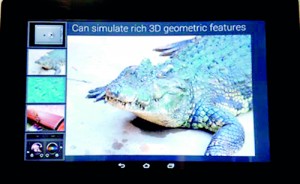Sunday Times 2
Now that’s a touchscreen
Imagine browsing through photos of animals and being able to stroke them through your phone’s screen, or ‘feel’ products before you buy them online.
Japanese firm Fujitsu has developed a prototype tablet that uses ultrasound vibrations to mimic a variety of textures.
These vibrations change the friction between the finger and the screen to trick the brain into thinking it’s plucking a harp, touching the skin of an alligator and more.
It can also give the sensation of touch a slippery liquid.

Virtual reality touchscreen: Japanese firm Fujitsu has developed a prototype tablet device that uses ultrasound vibrations to mimic a variety of textures, such an alligator's skin (pictured)
Other, similar technologies change the friction between the finger and the screen using static electricity, and Fujitsu claim the use of ultrasound is a world first.
It is also a breakthrough technology because ultrasound vibrations usually need a large amount of energy to work effectively. This is the first time it’s been developed to run on smaller devices with mobile batteries.
Fujitsu said: ‘While technologies already exist that convey texture by vibrating the touchscreen display panel itself or by generating static electricity, Fujitsu Laboratories has developed the industry’s first technology to use ultrasonic vibrations to convey tactile sensations by varying the friction between the touchscreen display and the user’s finger.
‘This technology enables tactile sensations – either smooth or rough, which had until now been difficult to achieve – right on the touchscreen display.
‘Users can enjoy realistic tactile sensations as they are applied to images of objects displayed on the screen.’
By varying the ultrasonic vibrations, using a layer beneath the screen, this reduces friction and creates what Fujitsu calls a ‘floating effect.’
This tricks the brain into think the screen is slippery, and mimics liquid.
To create a ‘bumpy or rough’ touch sensation, the prototype table quickly switches between high and low friction, in response to where the fingers are placed on the screen.
This combination of tactile information, visual information from the display, and audio information from the speakers can trick the brain into thinking it’s touching something physical.
Examples demonstrated by Fujitsu include a Japanese harp, which gives users the sensation of plucking the strings of a koto, a traditional Japanese harp.
The DJ demonstration gives the impression that users are touching a CD placed on a mixing deck, using volume and other controls as if they were physical buttons.
As a user turns the lock in the Vault demonstration, sound and tactile feedback gives the illusion of turning a combination lock on a safe.
While the Alligator demonstration gives the sensation of touching the skin of a real-life alligator.
Fujitsu continued: ‘By enabling more realistic and intuitive operability, the tactile sensory technology in this prototype has wide-ranging potential applications, including for electronic product catalogues, on tablets and other devices.’
© Daily Mail, London


